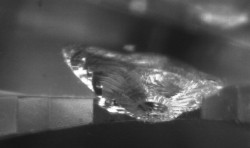Diamondexpert24*7
Wednesday, June 26, 2013
Friday, June 21, 2013
About Diamond in Brief
Diamond
Diamond is the most precious of the gemstone. The word "Diamond" originally comes from the Greek word "Adams" which means "Unconquerable".
Diamonds are formed by nature in the upper mantle of the earth’s crust. Crystallization took place millions and millions of years ago, under enormous pressure and at a very high temperature. Before being forced to the surface of the earth, they were stored in the upper mantle of the earth at a depth of 150-300km below the surface. The atoms in diamond are equidistant from one another.
Graphite and diamond both are the forms of carbon but with highly diverse properties. Diamond is the purest crystalline transparent form of carbon whereas charcoal, soot and coke are non-transparent and non-crystalline impure form of carbon. Diamond is bad conductor of electricity.
It is not surprising that rough diamonds are never completely free of impurities or irregularities in crystal structure. Growth of environment, chemical impurities can cause structural distraction; they can even scatter the crystal. In diamonds color vary so widely, sometimes it becomes difficult to judge the exact color.
Sine time in memorial up to 2600 minerals has been found in the earth’s crust, out of which one is diamond. Among all the minerals diamond is the hardest but not toughest (Jade is the toughest mineral of all), uncompressible, durable and indestructible gemstone. Only diamond can cut diamond. Diamond can withstand high temperature and great pressure but cannot withstand heavy hammering due to weak toughness. Diamond is brittle in nature. From where there is cleavage, diamond can be cleaved. Diamond’s original color can neither be changed nor destroyed. Diamond reflects light, and it is maximized with the cut.
In times of economic and monetary instability diamond has a very significant role to play. Acids and alcohol cannot change any of the properties of diamond like luster etc. Because of its size and value, diamond is the most valuable substance known. Diamond cannot be seen in the dark, because it doesn’t reflect its own light.
In astrology each gemstone represents different planets in the universe, diamond represents the planet Venus.
Diamond Properties
Reason for Colour in Diamonds
When ever we see a diamond,initially we come to a conclusion about its colour as Colourless or Tinted.Why we find one diamond as colourless and other as brown or yellow or any other colour.Why this difference?
Let us discuss
When diamonds contain interstetial imprities or structural defects,colour is observed.Diamonds are scientifically classified in to two main types and several subtypes
Let us discuss
When diamonds contain interstetial imprities or structural defects,colour is observed.Diamonds are scientifically classified in to two main types and several subtypes
- Type 1: Contains nitrogen which is subdivided into Type 1a and Type 1b.
- Type 1a: Nitrogen as clusters. Most natural diamonds fall in this type. It is further sub-divided into Type 1aA and Type 1aB depending on the arrangement of nitrogen atoms with or without a vacancy.
- Type 1b: Nitrogen is present in a single state as foreign atoms. Almost all synthetic diamonds and a very small of natural diamonds fall in this type.
- Type 2: Contains hardly any nitrogen but contains other elements which are subdivided into Type 2a and Type 2b.
- Type 2a: No appreciable nitrogen, generally brown, pink and colorless.
- Type 2b: Contain boron and as a result such diamonds are semi-conducting. Generally blue diamonds.
In short if we conclude
- Yellow/Brown colour in diamonds is due to Nitrogen and related color centers.
- Blue: Boron
- Green: Color center due to natural or artificial irradiation.
- Other colors are due to trace elements and related color centers.
Tuesday, June 18, 2013
Monday, June 17, 2013
What is your initial step when a diamond comes to your hand?
Don't be oversmart by grading a diamond when ever you take in to your hand initially .First important step is to check whether the stone is a CZ ?,a Moissanite ?.
If you confirm the stone as a Diamond,then try to grade.
If you confirm the stone as a Diamond,then try to grade.
Subscribe to:
Comments (Atom)










.jpg)
